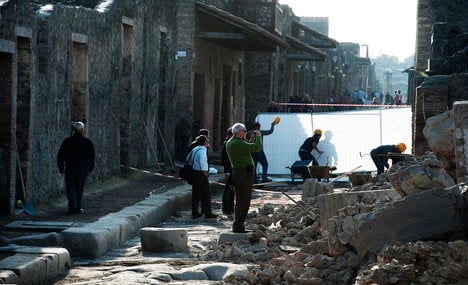Pompeii begins gladiator domus restoration

An elaborate restoration of a ruin once home to gladiators in the hours before they embarked on bouts to the death has got underway in Pompeii, five years after its collapse raised serious questions about the management of the famous Unesco site.
The gladiator domus, or Schola Armaturarum, on Pompeii's central Via dell'Abbondanza, was a building in which gladiators once kept their weapons and trained before battle.
More recently, it was a site once much admired by visitors thanks to its stunning, military-themed frescoes.
However, the impressive domus was transformed into a heap of rubble and dust on the morning of November 6th 2010, following a night of heavy rainfall.
The collapse was met with international condemnation and raised serious questions about whether Italy's most-visited cultural site was being funded and managed correctly.

The extent of the damage in 2010. Photo: Roberto Salomone/AFP
But visitors to the ancient city - which was destroyed and preserved in time by the eruption of Mount Vesuvius in 79 AD – will soon be able to admire part of the domus once again, after a restoration project finally got underway in late December.
Archaeologists are hopeful that the first phase of the operation will be complete by the end of February.
But rebuilding a collapsed Roman armoury is no easy feat.
A team of experts have been called in to help with the work, which has required that a temporary cover be built around the 40-foot wide ruin so that architects, and the ancient walls themselves, are protected from the elements during the restoration.
After the covering has been completed, the collapsed sections of the building's walls will be carefully raised, before their frescoes are restored by a team of ancient art experts.
But experts warned that after spending five years in a heap, damage to the walls is likely to be quite high.
“Before we can even begin we will have to remove any vegetation that is growing among the rubble,” architect Paulo Mighetto told La Repubblica, outlining the size of the challenge.
But all is not lost. In order to protect them from erosion, the most exposed pieces of frescoed wall were covered in plastic immediately following the collapse to protect them from the elements.
Mighetto explained that the initial phase of the €81,000 project would not, however, return the building to its former glory. “At the moment we have a project that will allow a partial restoration of the north, south and east walls of the building.”
Experts at the site are hopeful that at a full restoration of the building will be completed in time. Pompeii's archaeological superintendent, Massimo Ossana, said he saw the restoration as evidence that the site had turned itself around.
“It can't be anything other than a symbolic moment,” Ossana said.
Comments
See Also
The gladiator domus, or Schola Armaturarum, on Pompeii's central Via dell'Abbondanza, was a building in which gladiators once kept their weapons and trained before battle.
More recently, it was a site once much admired by visitors thanks to its stunning, military-themed frescoes.
However, the impressive domus was transformed into a heap of rubble and dust on the morning of November 6th 2010, following a night of heavy rainfall.
The collapse was met with international condemnation and raised serious questions about whether Italy's most-visited cultural site was being funded and managed correctly.

The extent of the damage in 2010. Photo: Roberto Salomone/AFP
But visitors to the ancient city - which was destroyed and preserved in time by the eruption of Mount Vesuvius in 79 AD – will soon be able to admire part of the domus once again, after a restoration project finally got underway in late December.
Archaeologists are hopeful that the first phase of the operation will be complete by the end of February.
But rebuilding a collapsed Roman armoury is no easy feat.
A team of experts have been called in to help with the work, which has required that a temporary cover be built around the 40-foot wide ruin so that architects, and the ancient walls themselves, are protected from the elements during the restoration.
After the covering has been completed, the collapsed sections of the building's walls will be carefully raised, before their frescoes are restored by a team of ancient art experts.
But experts warned that after spending five years in a heap, damage to the walls is likely to be quite high.
“Before we can even begin we will have to remove any vegetation that is growing among the rubble,” architect Paulo Mighetto told La Repubblica, outlining the size of the challenge.
But all is not lost. In order to protect them from erosion, the most exposed pieces of frescoed wall were covered in plastic immediately following the collapse to protect them from the elements.
Mighetto explained that the initial phase of the €81,000 project would not, however, return the building to its former glory. “At the moment we have a project that will allow a partial restoration of the north, south and east walls of the building.”
Experts at the site are hopeful that at a full restoration of the building will be completed in time. Pompeii's archaeological superintendent, Massimo Ossana, said he saw the restoration as evidence that the site had turned itself around.
“It can't be anything other than a symbolic moment,” Ossana said.
Join the conversation in our comments section below. Share your own views and experience and if you have a question or suggestion for our journalists then email us at [email protected].
Please keep comments civil, constructive and on topic – and make sure to read our terms of use before getting involved.
Please log in here to leave a comment.